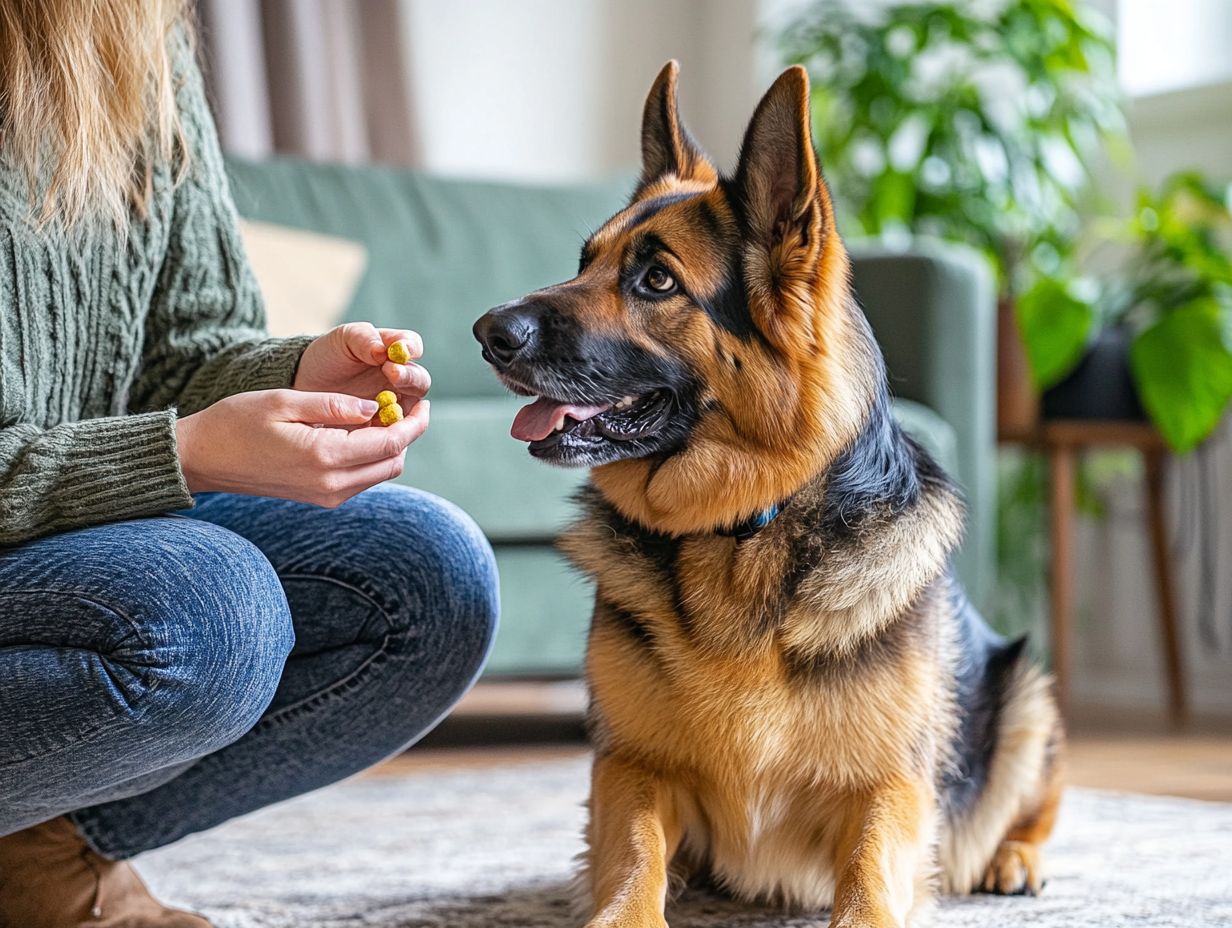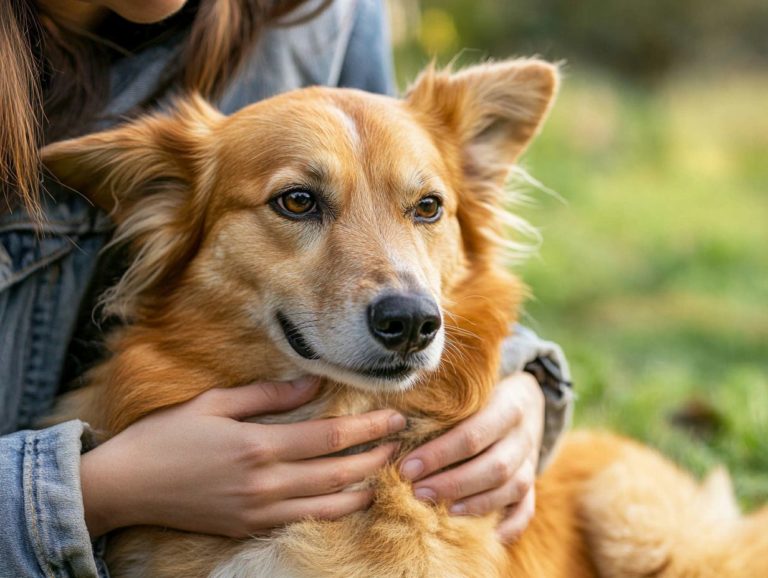Tips for Training Anxious Pets at Home
Pet anxiety is a growing concern for you as a pet owner, profoundly affecting the well-being of your furry companions.
From thunderous noises to shifts in routine, a variety of triggers can leave your pets feeling stressed and overwhelmed. This article delves into the causes and signs of anxiety in pets. It presents effective training techniques to help them cope and offers tips for creating a soothing environment at home.
It also addresses when it’s time to seek professional help. Understanding your pet’s anxiety is the key to their happiness!
Contents
Key Takeaways:

- Understand your pet’s anxiety triggers and take steps to avoid them.
- Learn to identify signs of anxiety in your pet and respond with positive reinforcement and desensitization techniques.
- Create a calming environment at home for your anxious pet by reducing stress and seeking professional help when needed.
Understanding Pet Anxiety
Understanding pet anxiety is essential for any discerning pet owner. It allows you to create a loving and stable environment for your pets.
This includes various feelings. It can greatly affect their well-being and behavior.
For many pets, anxiety may arise from factors such as separation issues or specific triggers that provoke anxious reactions. By recognizing these challenges, you can manage your pet’s emotional responses effectively.
This might even include seeking guidance from a professional dog trainer or behaviorist for personalized solutions that truly cater to your pet’s needs.
Causes and Common Triggers
A variety of causes and common triggers can lead to anxiety in pets, including environmental changes, loud noises, and separation from you.
For example, sudden thunderstorms or fireworks can startle many pets, prompting them to seek shelter or exhibit nervous behaviors like pacing or trying to hide.
Changes in routine like a family member moving out or shifts in your work hours can also unsettle them. Pets often communicate their unease through body language; you might notice signs such as excessive licking, tucked tails, or ears pinned back.
To help manage anxiety, consider creating a safe space where your furry friend can retreat when feeling overwhelmed. Utilizing calming aids and maintaining a consistent daily schedule can also make a significant difference in their comfort level.
Signs of Anxiety in Pets

Recognizing the signs of anxiety in pets is crucial for effective intervention and training. You may notice a range of behavioral changes in your pet, such as excessive barking, pacing, or even destructive actions. Implementing techniques like using scent training to calm anxious pets can be very helpful.
By understanding these signs, you can connect your pet s behaviors to underlying anxiety issues. Identifying anxious reactions early on can prevent escalation and enhance your chances of successful training efforts.
Identifying Behavioral Changes
Identifying behavioral changes in your pet is crucial for understanding their anxiety and crafting an effective training plan.
When you observe shifts like withdrawal, increased aggression, or excessive barking, you gain invaluable insights into your pet’s emotional state.
These signs often indicate underlying anxiety that requires your attention. To counteract these behaviors, employ positive reinforcement strategies, rewarding desirable actions to encourage a calm demeanor.
Creating positive associations through treats or praise when your pet faces stressors can transform their perspective. By implementing a structured training plan tailored to your pet’s unique needs, you can establish a sense of security that fosters improved behavior and strengthens the bond between you and your companion.
Start creating a calm space for your pet today!
Effective Training Techniques for Anxious Pets
Effective training techniques for anxious pets can profoundly alleviate their stress and enhance their overall quality of life. For instance, using tips for training an anxious dog in public can help foster positive associations with situations that typically trigger anxiety. By employing methods like positive reinforcement and desensitization, you can create a calmer environment for your pet.
These approaches not only minimize anxiety but also bolster your pet’s confidence, empowering them to confront their fears gradually and effectively.
Positive Reinforcement and Desensitization

Positive reinforcement and desensitization are your secret weapons in training anxious dogs, and understanding their needs can empower them to develop essential coping skills over time. For more insights, check out understanding the needs of anxious pets.
These methods create a friendly space where your dog can learn to associate once-frightening stimuli with positive experiences. For example, if your dog feels anxious around other dogs, gradual exposure paired with treats or praise can encourage a more relaxed demeanor.
The journey often begins with observing other dogs from a safe distance, rewarding calmness, and slowly closing that gap as your dog becomes more comfortable. This careful pacing is vital in managing anxiety; it builds your dog’s confidence and minimizes the risk of overwhelming fear, ultimately fostering a more balanced emotional state.
Creating a Calming Environment
Creating a calming environment is vital for reducing anxiety in pets and fostering their sense of security. Consider incorporating elements that establish a comforting space where your dog can feel relaxed and safe.
Think about gentle, soothing music that promotes tranquility. These adjustments help alleviate anxiety and cultivate a nurturing atmosphere for your dog to truly thrive.
Tips for Reducing Stress and Anxiety at Home
Reducing stress and anxiety at home involves practical tips that seamlessly integrate into your daily life, benefiting both you and your pets.
Establishing a reliable routine is key; pets thrive on predictability, and setting regular feeding and walking times can significantly alleviate their anxiety. Consider playing calming music to soothe a nervous pet, creating a serene atmosphere that encourages relaxation throughout your home.
Creating a comforting environment, perhaps with a cozy bed in a quiet corner, gives your pets a safe retreat when they feel overwhelmed. Engaging in consistent training sessions is also essential; it not only helps manage their anxiety but also builds their confidence. For additional strategies, check out these tips for training cats with anxiety issues and strengthens the bond between you and your furry companions.
Seeking Professional Help

Seeking professional help can be a crucial step for you as a pet owner navigating the challenges of your dog’s anxiety. Partnering with a certified separation anxiety trainer or an experienced dog trainer can offer you personalized strategies crafted to meet your pet’s distinct needs.
Consulting with a veterinarian can help identify any underlying medical issues that may be exacerbating the anxiety, ensuring a holistic approach to both behavioral training and anxiety management.
When to Consult a Veterinarian or Trainer
Knowing when to consult a veterinarian or a professional trainer can profoundly impact your success in managing your dog’s anxiety.
This decision rests on your ability to recognize certain clear signs indicating deeper emotional distress in your pet. Persistent anxiety may reveal itself in various forms, from excessive barking and destructive behavior to noticeable shifts in eating habits and social interactions.
If you observe these behavioral changes becoming more frequent or intense, it may be a sign that your dog is feeling overwhelmed and in need of assistance. Engaging a professional not only equips you with tailored strategies for anxiety management but also helps uncover underlying issues that could be contributing to the problem, ultimately enhancing your pet s overall well-being.
Don’t hesitate to reach out to a trainer or vet today for your pet’s peace of mind!
Preventing Future Anxiety in Pets
Preventing anxiety in pets is essential for their well-being. You can achieve this through thoughtful strategies and training techniques specifically for anxious breeds.
Establishing a dependable routine creates a sense of security for dogs, which helps reduce anxious reactions to changes. By providing consistent training and teaching coping skills, you empower your dogs to handle future stressors with confidence and resilience.
Long-Term Strategies for Managing Anxiety
Implementing long-term strategies can significantly enhance your pet’s mental well-being.
Creating a supportive environment and focusing on consistency helps your furry friends feel secure. Gradual exposure to anxiety-inducing situations like loud noises or interactions with other animals is essential. For effective strategies, consider the top 5 training techniques to reduce pet anxiety. This allows pets to acclimate comfortably over time, reducing their stress responses.
Establishing reliable routines, such as playtimes and feeding schedules, also contributes to a sense of stability. Maintain these methods consistently while observing your pets reactions. Be ready to adjust techniques as needed, and always practice patience.
Incorporating calming tools, like soothing music or pheromone diffusers, can enhance your strategies and boost the overall effectiveness of your anxiety management plan.
Frequently Asked Questions
What are some tips for training anxious pets at home?
1. Start slow and be patient. Anxious pets may take longer to learn, so give them the time they need. Utilizing training techniques to manage aggression in anxious pets can also be beneficial during this process.
2. Use positive reinforcement. Reward calm behavior with treats and praise instead of scolding.
3. Create a safe space. Ensure your pet has a comfortable area at home to help them feel at ease during training, following best practices for pet anxiety training.
4. Stick to a routine. Anxious pets thrive on routine, so establish a consistent training schedule.
5. Seek professional help. If your pet’s anxiety is severe, consider consulting a trainer or behaviorist who understands positive reinforcement for anxious pets.
6. Be understanding. Remember, your pet’s anxiety isn t their fault, and compassion goes a long way in helping them.






